|
|
|
 |
 |
 |
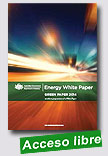 |
Energy White Paper - Green Paper 2014 - to inform preparation of a White Paper
Australia - Department of Industry, September 2014, 94 p.
The Energy White Paper is central to the Australian Government’s economic reform agenda for a strong and prosperous national economy. Reliable and affordable energy, used productively, supports business competitiveness, lowers the cost of living, and grows export income. There is no ‘silver bullet’ to achieve the change needed in the energy sector. Coherent and constructive market reform and
|
properly integrated polices will give industry and consumers confidence in energy policy.
Reforms are needed to create competition, and drive innovation and productivity. Competition encourages innovation, leading to better products and services. It also encourages better prices. Competition is best enabled through a deregulated environment. Sometimes, however, regulation is needed to protect consumers and the environment. Competition and deregulation improve productivity. Keeping costs down in the global energy market requires a focus on productivity in the extraction, production, supply and use of energy. Improved productivity will help attract investment, lower the cost of doing business in Australia, and lower
household energy costs. The more productive use of energy also reduces Australia’s emissions intensity.
This Green Paper includes market reforms designed to attract energy resources investment, stabilise energy price rises, and prepare for the nation’s future energy security.
Executive summary | Green Paper
Extraído de: http://www.ewp.industry.gov.au/files/egp/energy_green_paper.pdf
|
 |
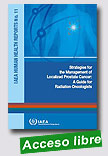 |
Strategies for the Management of Localized Prostate Cancer: A Guide for Radiation Oncologists
IAEA Human Health Reports, 2014, 39 p.
Clinical guidelines for the management of prostate cancer exist in the published literature. However, these guidelines have usually been developed in and for affluent health care environments where all modern diagnostic and treatment modalities are available. In limited resource environments, the radiation oncologist is faced with the question: what would be the minimum acceptable (evidence based) line of action with
|
the limited resources available? Clinical guidelines focusing on low-middle income countries aim to provide a practical tool to these practitioners. This publication is aimed at the radiation oncologists working in centres with limited resources and treating a large number of patients with prostate cancer on a daily basis. The approach and techniques recommended are intended to be simple, feasible and resource sparing to the extent that is possible when dealing with a complex treatment modality. It takes into consideration the cost benefit of the intervention to avoid unnecessary overtreatment of indolent tumours.
Extraído de: http://www-pub.iaea.org/books/IAEABooks/10618/Strategies-for-the-Management-of-Localized-Prostate-Cancer-A-Guide-for-Radiation-Oncologists |
 |
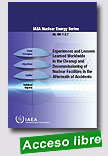 |
Experiences and Lessons Learned Worldwide in the Cleanup and Decommissioning of Nuclear Facilities in the Aftermath of Accidents
IAEA Nuclear Energy Series, 2014, 74 p.
This publication reviews experiences in IAEA Member States relevant to the cleanup and decommissioning of nuclear facilities in the aftermath of accidents and provides an overview of lessons learned worldwide. It also updates information from earlier publications on this topic, according to the different phases of activity after the accident has been declared ended (site stabilization, post-accident cleanup, safe enclosure) and, in the longer term, final decommissioning and site remediation. |
Extraído de: http://www-pub.iaea.org/books/IAEABooks/10621/Experiences-and-Lessons-Learned-Worldwide-in-the-Cleanup-and-Decommissioning-of-Nuclear-Facilities-in-the-Aftermath-of-Accidents
|
 |
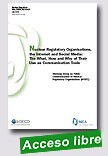 |
The purpose of this document is to provide information and research for those nuclear regulators that may be interested in integrating social media into their public communication strategies. This document also provides “tips and tricks” to help public communicators who are not specialists in social
|
media to begin developing successful and meaningful programs. Finally, this report delivers case studies and examples to provide “lessons learned” to member organisations interested in developing social media programs.
As with any new technology, there are benefits and drawbacks. The primary benefit of social media is the ability for regulators to reach out and talk directly to the public – and hear back – without the interpretation of a third party. However, social media can also lead to the quick spread of misinformation, and it takes tremendous resources to establish and maintain the platforms and produce content that builds a positive social media presence. Meeting the demands of social media speed can be especially challenging. It often means communicators must function with less management oversight and less formality in their messaging.
It should be noted that social media does not replace traditional means of communicating with the public. There remains a need for press releases, fact sheets and even public meetings to communicate to the public, special interest groups, other government organisations, industry and academia, and the media. These remain valid tools in a communicator’s tool box. But it can be argued that social media is no longer an optional endeavour.
Extraído de: http://www.oecd-nea.org/nsd/docs/2014/cnra-r2014-6.pdf
|
 |
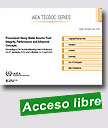 |
Pressurized Heavy Water Reactor Fuel: Integrity, Performance and Advanced Concepts
IAEA TECDOC (CD-ROM), 411 p.
Research and Development is undergoing in some Member States on the use of advanced fuels based on uranium, uranium-plutonium and thorium fuels in PHWRs. The objective of the meeting is to update the information on the status and
|
trends in the use of advanced fuels in PHWRs, their performances at high burnup and the technical readiness for the deployment of such fuel cycles in these types of reactor.
Extraído de: http://www-pub.iaea.org/MTCD/Publications/PDF/TE_1751_CD/Start.pdf |
 |
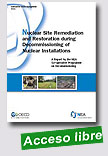
|
Nuclear Site Remediation and Restoration during Decommissioning of Nuclear Installations
Nuclear Energy Agency (NEA), 18/08/14, 244 p.
Decommissioning of nuclear facilities and related remedial actions are currently being undertaken around the world to enable sites or parts of sites to be reused for other purposes. Remediation has generally been considered as the last step in a sequence of decommissioning steps, but the values of prevention, long-term planning and parallel remediation are
|
increasingly being recognised as important steps in the process. This report, prepared by the Task Group on Nuclear Site Restoration of the NEA Co-operative Programme on Decommissioning, highlights lessons learnt from remediation experiences of NEA member countries that may be particularly helpful to practitioners of nuclear site remediation, regulators and site operators. It provides observations and recommendations to consider in the development of strategies and plans for efficient nuclear site remediation that ensures protection of workers and the environment.
Extraído de: http://www.oecd-nea.org
|
 |
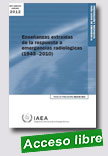 |
Enseñanzas extraídas de la respuesta a emergencias radiológicas (1945–2010)
IAEA Emergency Preparedness and Response, Julio 2014, 168 p.
El objetivo de esta publicación es examinar y agrupar las enseñanzas extraídas de una serie de emergencias radiológicas. Un objetivo adicional es demostrar la necesidad de adoptar disposiciones en materia de preparación y respuesta a situaciones de emergencia; en la publicación sobre Preparación y respuesta a situaciones de emergencia nuclear o radiológica –GS-R-2 – se proporcionan las bases para la adopción de esas disposiciones. |
Extraído de: http://www-pub.iaea.org/MTCD/Publications/PDF/EPR_LessonsLearned_2012_S_web.pdf
|
 |
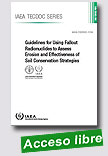 |
Guidelines for Using Fallout Radionuclides to Assess Erosion and Effectiveness of Soil Conservation Strategies
IAEA TECDOC (CD-ROM), 2014, 226 p.
The conservation of soil and water resources has become a major concern for ensuring global food production. Soil erosion is a worldwide threat and represents the main mechanism of land degradation in both developed and developing countries. To control soil erosion, there is a need to monitor the impacts of land use and assess the effectiveness of specific soil conservation technologies. Fallout |
radionuclides (FRNs) have proven to be a cost effective tool to trace soil redistribution due to erosion within the landscape from plot to basin scale and can complement the information provided by conventional erosion measurements and
modelling.
The purpose of this publication is to provide up to date information on the use of FRNs, such as caesium-137 (137Cs), lead-210 (210Pb) and beryllium-7 (7Be), to assess soil erosion magnitude in agricultural land. It summarizes the state of the art in the use of these fallout radionuclides as tracers, the main assumptions, the requirements and their limitations, which have to be recognised when using FRNs as soil tracers.
Extraído de:
http://www-pub.iaea.org/MTCD/Publications/PDF/TE-1741_web.pdf
|
 |
|
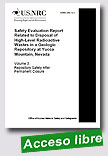
|
Safety Evaluation Report Related to Disposal of High-Level Radioactive Wastes in a Geologic Repository at Yucca Mountain, Nevada, Volume 3, NUREG 1949
United States Nuclear Regulatory Commission, October 2014, 781 p.
The Nuclear Regulatory Commission staff has published Volume 3 of its safety evaluation report on the proposed underground geologic nuclear waste repository at Yucca Mountain, Nev.
|
Volume 3 covers the period after a repository at Yucca Mountain would be permanently closed should NRC authorize construction following completion of the remaining steps in the licensing process. Volume 3 contains the staff’s finding that the Department of Energy’s repository design meets the requirements that apply after the repository is permanently closed, including but not limited to the post-closure performance objectives in NRC’s regulations (in 10 CFR Part 63, Subpart E). These performance objectives include the requirement that the repository be composed of multiple barriers to isolate radioactivity from the environment. The staff also found the proposed repository design meets the NRC’s limits or standards (in 10 CFR Part 63, Subpart L) for individual protection, human intrusion and groundwater protection.
The Department of Energy submitted its Yucca Mountain application in June 2008. The NRC staff published Volume 1 (General Information) of the safety evaluation report in August 2010. After DOE moved to withdraw the application and Congress stopped appropriating funds for the NRC’s review, the agency closed out its application review and published three technical evaluation reports containing the staff’s technical analyses to that point but no regulatory conclusions. The adjudication of nearly 300 contentions filed by various parties contesting the application was also suspended in September 2011.
The U.S. Court of Appeals for the District of Columbia Circuit ordered the NRC in August 2013 to resume the licensing process using currently available funding appropriated from the Nuclear Waste Fund. That court order led to today’s publication of Volume 3. The staff expects to publish volumes 2 (Repository Safety Before Permanent Closure), 4 (Administrative and Programmatic Requirements) and 5 (License Specifications) by January 2015, as they are completed.
Publication of Volume 3 does not signal whether the NRC might authorize construction of the repository. A final licensing decision, should funds beyond those currently available be appropriated, could come only after completion of the safety evaluation report, a supplement to the Department of Energy’s environmental impact statement, hearings on contentions in the adjudication, and Commission review.
Extraído de: http://www.nrc.gov/reading-rm/doc-collections/news/2014/14-069.pdf
|
 |
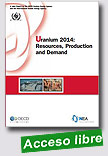 |
Uranium 2014: Resources, Production and Demand
Nuclear Energy Agency (NEA) and International Atomic Energy Agency (IAEA), 2014, 508 p.
In addition to updated resource figures, Uranium 2014 – Resources, Production and Demand presents the results of the most recent review of world uranium market fundamentals and offers a statistical profile of the world uranium industry as of 1 January 2013. It contains official data provided by 36 countries and 9 national reports prepared by the joint NEA-IAEA Secretariat on uranium exploration, resources, production
|
and reactorrelated requirements. Projections of nuclear generating capacity and reactor-related uranium requirements through 2035 are presented, as well as a discussion of long-term uranium supply and demand issues
Extraído de: http://www.oecd-nea.org/ndd/pubs/2014/7209-uranium-2014.pdf
|
| |
| |
|
|
| |
|
|
|
| |
|
|
|
| |
|
|
|
|
|
